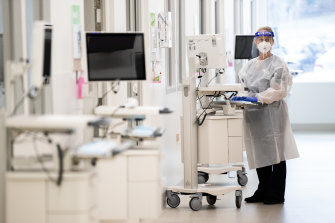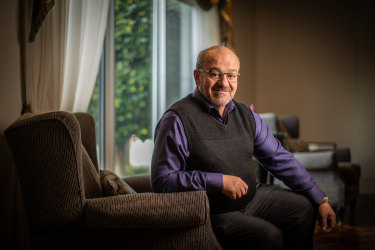Home » World News »
GPs warn of deadly flaws in COVID-at-home system
For our free coronavirus pandemic coverage, learn more here.
Victoria faces a surge in the number of coronavirus patients who will need to be treated at home instead of a hospital, and health authorities say those people could be at risk without more resources to care for them.
Internal department projections show that the state is on the brink of a 10-fold increase in COVID-19 infections over the next six weeks as restrictions ease, with a predicted 18,000 active coronavirus cases and 800 people in hospital by mid-October.
A paediatric nurse helps prepare extra beds at the Monash Medical Centre on Wednesday.Credit:Jason South
The vast majority of cases, however, will involve COVID-19 patients who are monitored at home as part of a triaging process designed to take pressure off Victoria’s stretched public health system.
Under this process, which was established during last year’s second wave, only the most serious cases end up in hospital. Low-severity patients are meant to receive a daily call from their GP as they isolate at home, while people with mildly severe cases receive visits from a nurse as well as telephone check-ups.
However, GPs say that without more resources to monitor patients and ensure they have the medical care and social support that they need, lives could be placed at risk.
“We had two people die in their homes a few weeks ago, which was terrible, and unless we get the surveillance right, we will keep having that,” said Dr Ines Rio, chair of the North Western Melbourne Primary Health Network.
“So we really need to support the system to do what we did last year but with greater numbers, to ensure we have a proper service to check on people and make sure they have what they need.”
There are currently 2000 active coronavirus cases involving people being monitored at home, according to Health Department figures.
The deaths Dr Rio cited involved two COVID-positive patients – a woman in her 40s from the Darebin area and a Hume woman in her 60s – whose circumstances will be subject to a coronial inquiry.
But the tragedies led to GPs exposing another gap in the system this month: that they were not always told when their patients test positive to coronavirus until days after their diagnosis, forcing some to call ambulances for people who have deteriorated in their homes.
Newport GP Hanna El-KhouryCredit:Scott McNaughton
Western suburbs GP Hanna El-Khoury told The Age that “communication breakdowns and health bureaucracy” had kept him in the dark about patients infected with the virus.
“By the time I have spoken to some patients, they have deteriorated quickly and after assessing them over the phone I have had to call an ambulance,” he said this month.
The need for proper resourcing is particularly acute in the northern and western suburbs of Melbourne where the bulk of COVID-19 cases are concentrated, prompting epidemiologists and the state’s Australian Medical Association to call for incentives to keep people in these coronavirus hotspots in their homes, and for essential workers in the north and western suburbs to have their vaccinations brought forward.
As The Age reported this month, Victoria’s health system is under strain, from ambulance response times and access to mental health beds, to dental waiting lists and the number of hospital patients receiving urgent treatment. Patients are arriving sicker after putting off care or having their surgeries delayed due to the pandemic, resulting in more people flooding emergency departments than ever before.
While the government says it has enough ICU beds to treat an expected influx of patients, finding enough nurses and other health professionals to staff them will be the greatest challenge.
Dr Karen Price, president of the Royal Australian College of General Practitioners, said a well-resourced primary care system would help to ensure more COVID patients received the support they needed from their GPs, which would prevent many from deteriorating to the point that they need hospital.
“We’re going to need to look at how we manage respiratory illness going forward in any healthcare setting because there’s going to be COVID circulating and we’re going to have vulnerable people,” she said.
“We can certainly help our hospital colleagues in providing those kinds of services but we need the infrastructure and we need the money spent.”
On Sunday, Victoria recorded 392 new locally acquired cases, but only 107 were linked to existing outbreaks.
A Health Department spokesman said the department was “doing everything we can to keep Victorians safe from COVID-19”.
“As well as providing Victoria’s health services with the beds and equipment they need to care for more seriously ill patients, care and support is also provided to people who test positive in the comfort of their home, freeing up beds at health services.”
With Melissa Cunningham
Stay across the most crucial developments related to the pandemic with the Coronavirus Update. Sign up for the weekly newsletter.
Most Viewed in National
From our partners
Source: Read Full Article




